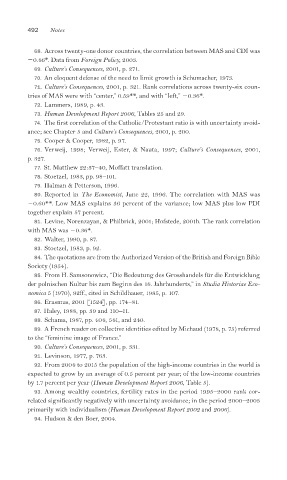Page 527 - Cultures and Organizations
P. 527
492 Notes
68. Across twenty-one donor countries, the correlation between MAS and CDI was
0.46*. Data from Foreign Policy, 2003.
69. Culture’s Consequences, 2001, p. 271.
70. An eloquent defense of the need to limit growth is Schumacher, 1973.
71. Culture’s Consequences, 2001, p. 321. Rank correlations across twenty-six coun-
tries of MAS were with “center,” 0.59**, and with “left,” 0.36*.
72. Lammers, 1989, p. 43.
73. Human Development Report 2006, Tables 25 and 29.
74. The first correlation of the Catholic/Protestant ratio is with uncertainty avoid-
ance; see Chapter 5 and Culture’s Consequences, 2001, p. 200.
75. Cooper & Cooper, 1982, p. 97.
76. Verweij, 1998; Verweij, Ester, & Nauta, 1997; Culture’s Consequences, 2001,
p. 327.
77. St. Matthew 22:37–40, Moffatt translation.
78. Stoetzel, 1983, pp. 98–101.
79. Halman & Petterson, 1996.
80. Reported in The Economist, June 22, 1996. The correlation with MAS was
0.60**. Low MAS explains 36 percent of the variance; low MAS plus low PDI
together explain 57 percent.
81. Levine, Norenzayan, & Philbrick, 2001; Hofstede, 2001b. The rank correlation
with MAS was 0.36*.
82. Walter, 1990, p. 87.
83. Stoetzel, 1983, p. 92.
84. The quotations are from the Authorized Version of the British and Foreign Bible
Society (1954).
85. From H. Samsonowicz, “Die Bedeutung des Grosshandels für die Entwicklung
der polnischen Kultur bis zum Beginn des 16. Jahrhunderts,” in Studia Historiae Eco-
nomica 5 (1970), 92ff., cited in Schildhauer, 1985, p. 107.
86. Erasmus, 2001 [1524], pp. 174–81.
87. Haley, 1988, pp. 39 and 110–11.
88. Schama, 1987, pp. 404, 541, and 240.
89. A French reader on collective identities edited by Michaud (1978, p. 75) referred
to the “feminine image of France.”
90. Culture’s Consequences, 2001, p. 331.
91. Levinson, 1977, p. 763.
92. From 2004 to 2015 the population of the high-income countries in the world is
expected to grow by an average of 0.5 percent per year; of the low-income countries
by 1.7 percent per year (Human Development Report 2006, Table 5).
93. Among wealthy countries, fertility rates in the period 1995–2000 rank cor-
related significantly negatively with uncertainty avoidance; in the period 2000–2005
primarily with individualism (Human Development Report 2002 and 2006).
94. Hudson & den Boer, 2004.

